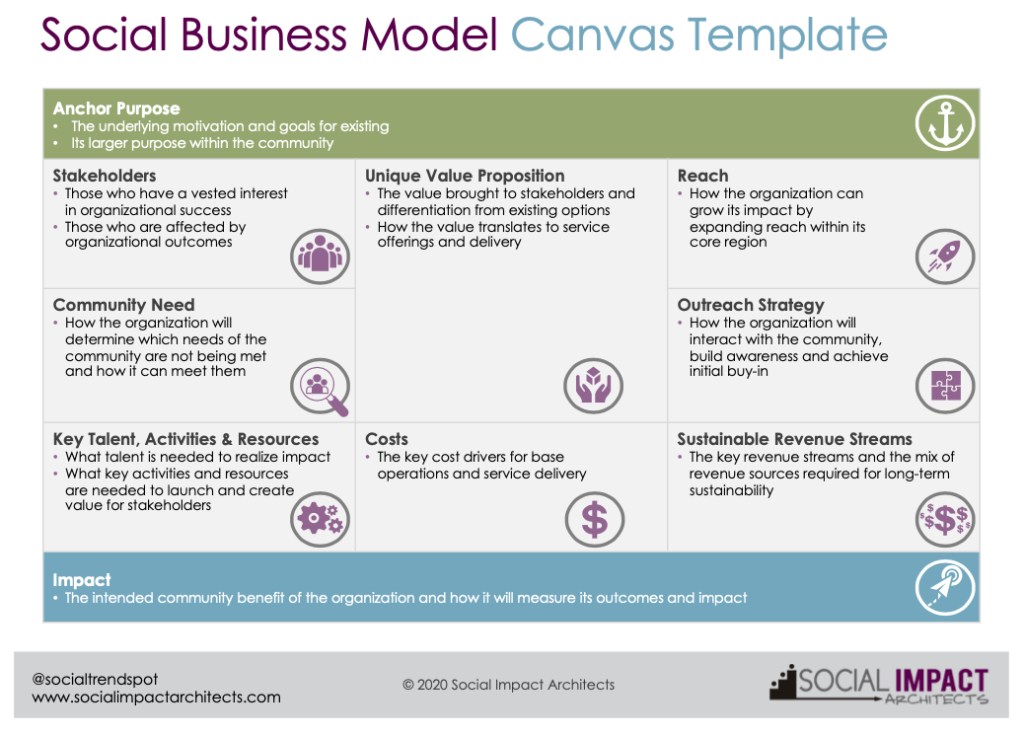 “Evolve or die” – this saying is even more true today than when I started Social Impact Architects. Just 10 years ago, I learned about social business plans in business school, but today traditional business plans are being replaced by a more efficient tool – the business model canvas. Developed in 2005 by business scholar Alexander Osterwalder, the business model canvas is a widely-used framework for analyzing a new business idea. The canvas asks that the idea creator answer how key components of the business would operate – things like revenue and value proposition. Its popularity can be attributed to its universality – nearly any business idea can be analyzed through this framework. And, it is simple and easy, which is why it has replaced the business plan as the first step toward business creation.
“Evolve or die” – this saying is even more true today than when I started Social Impact Architects. Just 10 years ago, I learned about social business plans in business school, but today traditional business plans are being replaced by a more efficient tool – the business model canvas. Developed in 2005 by business scholar Alexander Osterwalder, the business model canvas is a widely-used framework for analyzing a new business idea. The canvas asks that the idea creator answer how key components of the business would operate – things like revenue and value proposition. Its popularity can be attributed to its universality – nearly any business idea can be analyzed through this framework. And, it is simple and easy, which is why it has replaced the business plan as the first step toward business creation.
For our work at Social Impact Architects, we have created a customized version of the business model canvas for our nonprofit and social entrepreneur clients called the “social business model canvas.” HUGE THANKS to David Claps, senior consultant, for all his effort on the amazing work. We needed to adapt the model for a few reasons.
First, the canvas allows us and our clients to test out a new idea early on in the strategy development process using criteria unique to the social sector (e.g., community need, sustainable revenue streams). A key benefit of the modified canvas is that it forces social entrepreneurs and nonprofit leaders to acknowledge the tension between impact and revenue. A viable social sector business idea must support both. The idea must generate impact – community benefit that brings something new to the table – through an ongoing commitment to evolve the idea. It must also ensure there are stakeholders who value the idea enough to support it through a mix of revenue streams and a plan for long-term sustainability. If the idea can’t pass the test of the social business model canvas – for example, because you discover that your unique value proposition doesn’t connect to how you generate revenue – you can quickly see that the idea is not feasible or needs tweaking before much time or effort is invested.
Second, fewer and fewer nonprofits and socents are spending the time, energy and money on developing full business plans. We suspect this is the case because of the chicken-and-egg scenario nonprofits and social entrepreneurs face: in order to fund a new business idea, you need capital from your trusted partners and funders. But, to secure the new capital, you need to expend existing capital on developing a business plan you can use to influence your funders. This is an expensive task, especially when organizations have limited unrestricted funds available, making it a high-risk endeavor. Social business model canvas allows organizations to articulate the business fundamentals of a new idea without going into extraneous detail. It is also easily digested and highly presentable – great for external stakeholders.
Third, the full business plan is also falling out of favor with entrepreneurs. Compared to a business plan, the canvas better complements the tenets of lean startup where you develop a quick prototype and gather rapid feedback for further iteration. It helps you get your ideas on paper in a quick way that is easily shared when you’re looking for input from your colleagues, customers or funders.
While the standard business model canvas is beneficial for nearly any type of business, it was not built with the nuances of the social sector in mind. For it to answer the right questions and serve as a litmus test for social business or program ideas, we have augmented the original framework. We have merged, renamed or removed many of the original components while also adding some new components we think are important to the social sector. In our version, the main components are supported by the bookend considerations of anchor purpose and impact.
Anchor Purpose
-
- The underlying motivation and goals for existing
- Its larger purpose within the community
Similar to a mission statement, all components of the idea should connect with your stated anchor purpose. If they do not, you can see right away the idea might lead to mission drift or need further finessing.
Stakeholders
-
- Those who have a vested interest in organizational success
- Those who are affected by organizational outcomes
Think about stakeholders broadly. They are not just funders, but also those you intend to serve as well as community members at-large. It may help to define your primary and secondary stakeholders and analyze how the idea will affect these groups in similar or dissimilar ways.
Community Need
-
- How the organization will determine which needs of the community are not being met and how it can meet them
In general, we advise clients to work in areas of well-documented community need. Otherwise, potential impact may never be fully realized. You should be able to articulate how your idea will meet a need – and that the need is not already sufficiently serviced by another organization.
Unique Value Proposition
-
- The value brought to stakeholders and differentiation from existing options
- How the value translates to service offerings and delivery
You should be able to articulate what value your idea creates – for your organization, for your community, for all your stakeholders – and how it is unique. The unique value proposition should describe why your idea is worth doing.
Key Talent, Activities and Resources
-
- What talent is needed to realize impact
- What key activities and resources are needed to launch and create value for stakeholders
Think about all the inputs needed to get your idea off the ground. This could include additional funding, more or different staff, or more time from executive leadership. Be sure to prioritize these needs so you can launch in the order required.
Costs
-
- The key cost drivers for base operations and service delivery
While it is tough to come up with every cost without moving onto to a full business plan and financial model, you should have a grip on the main cost drivers. It may help to think through both fixed and variable costs as well as start-up costs. Do not forget to include the operating costs that will add to overhead as well as variable programmatic costs.
Reach
-
- How the organization can grow its impact by expanding reach within its core region
No matter the size and scope of impact intended, the success of your business idea is likely predicated on growth. In this section, think about how far and how fast you want to grow your reach and how you will do it. Organically over time? Through partnerships? Understand the viable options.
Outreach Strategy
-
- How the organization will interact with the community, build awareness and achieve initial buy-in
Think about how you will drive attention at the start of the business as well as in the long-term. If this is a client-based idea, will you bring in initial clients by hiring a well-connected local leader? If your idea is to launch programs in a part of your state you have not worked in before, will you secure a partnership with a leading organization in that region? The strategy can be varied here, but before you get moving, you must understand the pathways to build awareness.
Sustainable Revenue Streams
-
- The key revenue streams and the mix of revenue sources required for long-term sustainability
Your revenue streams will likely connect to your stakeholders – some segment(s) of those you serve will generate revenue for the business line or organization. Make sure you understand what will generate revenue, not only at the start of the business, but also for the long-term. If your business model relies on earned income, you will also need to determine how the market will support your pricing. For example, is the market most agreeable to fee-for-service or sliding scale pricing?
Impact
-
- The intended community benefit of the organization and how it measures its outcomes
Think about your idea in the future. If your business or program idea takes off, how are your stakeholders positively impacted – in the short-term and in the long-term? How will you measure it? This – like the anchor purpose – is the foundation of the canvas.
Our hope is this revamped version of business model canvas will serve as a valuable tool whenever you are working on strategy and considering changes to your social sector business or program. With a full business plan falling out of use, we hope this template will help you think through your ideas more efficiently. We also suspect this may be a useful tool in the time of COVID where organizations are looking to strategize quickly and cheaply to respond to emergent community needs. We would love your feedback after you use the canvas – we will continue to add new ideas and tips as we continue to use this with our clients and students.

